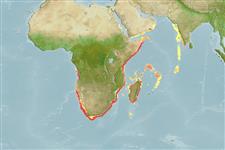Elasmobranchii (Haie und Rochen) (sharks and rays) >
Rajiformes (Skates and rays) >
Rajidae (Skates)
Etymology: Dipturus: Greek, di = two + Greek, pteryx = fin (Ref. 45335).
Environment: milieu / climate zone / depth range / distribution range
Ökologie
seewasser bathydemersal; tiefenbereich 88 - 740 m (Ref. 11284), usually 400 - 500 m (Ref. 5578). Deep-water; 21°N - 37°S, 11°E - 77°E (Ref. 114953)
Southeast Atlantic and Western Indian Ocean: in scattered localities from Lüderitz, Namibia round the Cape (South Africa) to central Mozambique; also off Madagascar and Kenya; also found off India and Oman (Ref. 114953).
Size / Gewicht / Alter
Maturity: Lm ? range ? - ? cm
Max length : 192 cm TL Männchen/unbestimmt; (Ref. 114953)
Kurzbeschreibung
Morphologie | Morphometrie
An all-dark longnose skate with its underside uniformly roughened by small denticles; snout acutely pointed and greatly elongated, and tail moderately stout and not conspicuously swollen; pectoral disc angular and broader than in other longnose skates in the area; no nape thorn (Ref. 5578). Dark grey to blackish above and below, ventral mucous pores black (Ref. 5578).
Inhabits the outer shelf and upper slope (Ref. 5578). Rarely caught, probably inhabits hard bottoms that are seldom trawled (Ref. 114953). Feeds on bony fish, crabs and squid (Ref. 5578, Ref. 114953). Oviparous (Ref. 50449). Eggs have horn-like projections on the shell (Ref. 205). Males reaches maturity at 125-135 cm TL, females at 170-190 cm TL. Smallest known specimen at 27 cm TL (Ref. 114953) Probably caught by hake trawlers (Ref. 5578).
Life cycle and mating behavior
Geschlechtsreife | Fortpflanzung | Ablaichen | Eier | Fecundity | Larven
Oviparous, paired eggs are laid. Embryos feed solely on yolk (Ref. 50449). Eggs have horn-like projections on the shell (Ref. 205).
McEachran, J.D. and K.A. Dunn, 1998. Phylogenetic analysis of skates, a morphologically conservative clade of elasmobranchs (Chondrichthyes: Rajidae). Copeia 1998(2):271-290. (Ref. 27314)
IUCN Rote Liste Status (Ref. 130435)
Bedrohung für Menschen
Harmless
Nutzung durch Menschen
Fischereien: nicht kommerziell
Mehr Information
ReferenzenAquakulturAquakultur ProfilZuchtlinienGenetikElectrophoresesVererbbarkeitKrankheitenVerarbeitungNutrientsMass conversion
Tools
Zusatzinformationen
Download XML
Internet Quellen
Estimates based on models
Preferred temperature (Ref.
123201): 6.4 - 12.5, mean 10.4 °C (based on 32 cells).
Phylogenetic diversity index (Ref.
82804): PD
50 = 0.5000 [Uniqueness, from 0.5 = low to 2.0 = high].
Bayesian length-weight: a=0.00275 (0.00175 - 0.00433), b=3.20 (3.07 - 3.33), in cm total length, based on LWR estimates for this species & Genus-body shape (Ref.
93245).
Trophic level (Ref.
69278): 4.3 ±0.69 se; based on food items.
Widerstandsfähigkeit (Ref.
120179): niedrig, Verdopplung der Population dauert 4,5 - 14 Jahre. (Fec assumed to be <100).
Fishing Vulnerability (Ref.
59153): Very high vulnerability (90 of 100).
